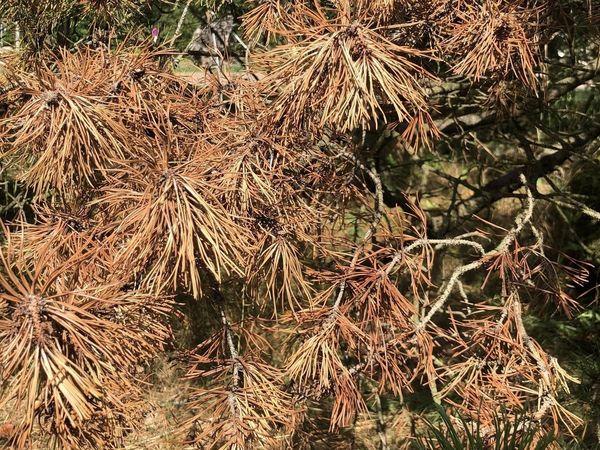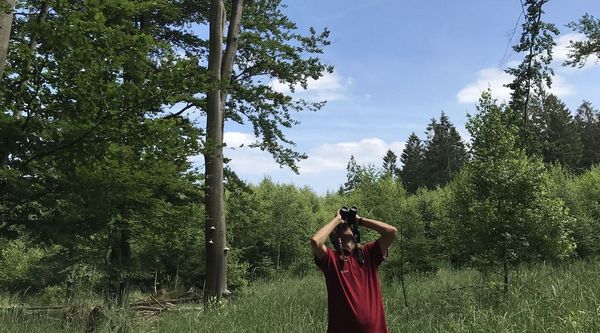Expertise
Forests in (climate) change: In worse condition despite a wet winter
Nicole Wellbrock | 13.05.2024
Forests in Germany, especially the main tree species spruce, beech, pine and oak are getting worse. Monitoring data from the Forest Condition Survey show that there have also been bad times for forests in recent decades due to storm events, acid rain or infestations by harmful insects. Since 2018, however, climate change-induced persistent drought has led to unprecedented levels of damage, which the precipitation in 2023 has hardly changed.
One third of the national area of Germany is forested. 90% of the forests covered by 11 tree species. With almost two-thirds of all forest trees, four main tree species dominate the stocks: spruce (Picea abies) with 25%, Scots pine (Pinus sylvestris) with 23%, copper beech (Fagus sylvatica) with 16%, and oak (sessile oak Quercus petraea and English oak Quercus robur) with 10%. But only a healthy forest can fulfill its functions as a source of timber, carbon sink, water reservoir and recreational area.
How do you determine the health of a forest?
Tree crowns provide valuable clues on tree vitality. The Forest Condition Survey (Waldzustandserhebung - WZE) collects important information on the status of crown condition out annually. Inventory teams examining the condition of selected tree crown parameters like the degree of defoliation (needle and leaf loss) in relation to a reference tree classified in five-percent classes. Defoliation is the result of numerous factors that adversely affect tree health. These include the amount of nitrogen input, weather conditions, as well as insect and disease infestations, fructification, or the age of the tree. Therefore, defoliation is an important indication of tree health.
In addition, other visual parameters are recorded to provide information on tree vitality of the trees and the causes of defoliation. For example, the intensity of fruit formation, yellowing of leaves or needles, insect and fungal infestations, and trunk and crown injuries.
Forest Condition Survey in brief
Already since 1984 in the former West German states and since 1990 in the whole federal territory the Forest Condition Survey is carried out as part of the European Forest Monitoring and the federal regulation called ForUmV, which is based on the National Forest Act (§41a Absatz 6 BWaldG).
The survey is carried out on a systematic 16 x 16 km grid (Level I grid) at approx. 10,000 trees and allows representative results for the most important tree species at the federal level. The data are evaluated at the Thünen Institute of Forest Ecosystems and are included in the annual National Forest Condition Report of the Federal Ministry for Food and Agriculture.
Still only one in five trees without damage - old trees are particularly affected
The poor condition of the forest affects all main tree species equally: As last year, only one in five trees is without damage. Pine trees are a small exception. The proportion with significant defoliation (36 percent) has actually increased slightly by one percentage point compared to the previous year. The proportion without defoliation was 20 percent in 2023 and thus at a similar level to the previous year (21 percent). The average defoliation of all tree species was almost unchanged at 25.9 percent.
Particularly old trees over 60 years of age showed significant defoliation; old trees find it difficult to adapt to changing climatic conditions. In this group, the proportion of significant defoliation is 43 percent.
It was noticeable last year that beech and pine in particular produced more fruit. Crown defoliation is higher in years with increased fruit formation. Studies show a connection between the so-called mast years , increased nitrogen inputs from the air and dry and warm previous years such as 2022. 2023 was the warmest year since the German Weather Service began recording the weather in 1881.
As there were no major storms in 2023, the precipitation rate fell from 6.7 percent to 4.7 percent. The drop-out rate refers to the proportion of trees that fell out of the sample. The still high drop-out rate of spruce was 9.0 percent, of which 4.3 percent was biotic, i.e. caused by infestation such as the bark beetle.
Defoliation of less common tree species investigated for the first time
As a result of ash dieback, ash trees have shown a steady increase in mean crown thinning since 2010. Since 2018, defoliation has been significantly higher than in all other tree species examined. The downy birch showed particularly high values in the dry years 2018 to 2020, but was able to recover again.
This contrasts with the silver birch, which has had high average defoliation values in recent years, even in more favorable weather conditions. Silver fir has been below the level of spruce since 2015. Species with comparatively low crown thinning include sycamore, black alder and Douglas fir.
Defoliation and death rate behavior develop differently
Until 2018, deciduous trees had a significantly higher average defoliation than conifers. However, this is currently at a similar level for beech and oak as for spruce. However, the death rate remains high only in spruce and ash.
Conifers are particularly affected, above all the spruce (Picea abies), which is breaking records in terms of the rate of excretion. One factor favoring this development is the large-scale cultivation of the drought-prone tree species as a monoculture. Weakened by a lack of water, the often pure spruce stands are particularly susceptible to infestation by bark beetles and storms. As a result, the needles begin to turn brown, fall off and the trees die.
The proportion of significant defoliation increased from 40 percent in 2022 to 43 percent in 2023. The warning level accounted for 40 percent, four percentage points more than in the previous year. Only 17 percent were without defoliation, seven percentage points less than in 2022. The average crown defoliation fell slightly from 29.6 to 28.6 percent.
Spruce is the most common conifer in Germany's forests, accounting for around 25 percent of the area. As fast-growing wood suppliers, they have been cultivated on a large scale for many years. However, this moisture- and cold-loving tree species, which originates from northern forests, cannot cope well with increasing drought. Its associated large-scale dieback has been changing the face of the forests for several decades, particularly in recent years.
European beech (Fagus sylvatica) is one of the most common deciduous trees in Germany's forests. Without human influence, the beech would even be the most common tree species in Germany.
For many years now, they have been suffering from insufficient precipitation and persistently high nitrogen inputs via the air. This is evidenced by the increasing proportion of defoliation over time as well as the ever shorter intervals between mast years, which indicate weakened stands.
In beech, the proportion of significant defoliation increased by one percentage point to 46 percent. The warning level accounted for 39 percent (2022: 34 percent). In the current inventory, there were only 15 percent without defoliation. In 2022, it was still 21 percent. The average defoliation has also worsened slightly to 28.5 percent. The results show that 61 percent of the beech trees have formed fruit. This percentage was also higher than in the previous year.
The pine tree benefits from the fact that its deep roots are adapted to dry conditions. Compared to the previous year, the condition of the pine has eased somewhat. The proportion of significant defoliation has fallen from 28 to 24 percent. The warning level accounted for 53 percent, six percentage points less than in 2022. The proportion without thinning increased from 13 to 23 percent. The average defoliation fell from 23.9 to 22.3 percent in 2023. However, the pines also produced more fruit last year. 83 percent of all trees bore fruit, of which around 29 percent were medium and four percent heavy.
Oak stands (sessile oak Quercus petraea and English oak Quercus robur) grow relatively old and are therefore particularly susceptible to damage. In particular, biotic damage communities such as the oak processionary moth in combination with powdery mildew regularly infest the stands and lead to phases of particularly high defoliation.
In the case of oak, the proportion of significant defoliation has risen by four points to 44 percent. In contrast, the proportion in the warning stage fell slightly from 41 to 39 percent. The proportion without thinning also fell slightly from 19 to 17 percent. The average defoliation increased slightly from 26.1 to 27.6 percent. The fruiting of the oak was significantly lower compared to 2022.
Bad times are not new
Similar poor conditions of the tree crowns have already occurred in two other periods in the history of Forest Condition Surveys:
Between 2003 and 2006, the level of damage was nearly as high as it is currently - a consequence of the dry year 2003 and the associated water shortage. Extreme weather conditions as a consequence of climate change, such as record heat summers and storms, e.g. hurricane "Kyrill" in 2007, have therefore already had a clear and negative impact on the external appearance of forest trees almost 20 years ago. However, as these were individual years, the forests were able to recover in times of better weather. Nevertheless, the continuing high nitrogen inputs are a burden on the forests.
Another, even earlier, collapse in forest health is evident between 1991 and 1994 as a result of the acid rains of the 1980s. Sulfur oxides from industry become sulfuric acid in the air and later fall back to earth as acid rain. In the soil, they lead to acidification, nutrient imbalances, and harmful aluminium concentrations for tree roots. This has been referred to as "forest dieback." Policy countermeasures taken by the federal government to curb sulfur oxide emissions have included the introduction of catalytic converters in cars and filtration systems in the industry. In addition, liming of forests was undertaken to neutralize acidification. Although tree populations have recovered as a result, the acidification of forest soils continues to have consequences for forest health to this day.
Support for the forests
Despite the high level of precipitation in 2023, the recovery phase can quickly come to an end during a hot and dry period in spring and summer. It is therefore necessary to continue the forest conversion to climate change-adapted mixed forests.
One key is species-rich forests, which, unlike spruce monocultures, are more resilient, meaning they can better adapt to climate change-induced extreme weather. To improve these forest ecosystem services, the German government has provided forest owners with 130 million euros per year. Various EU regulations such as the Soil Monitoring Law are intended to better protect forests.
Steps in this direction are the conversion to deciduous forests with uneven-aged, climate-stable mixed forests with "future tree species" or "assisted migration" - the acceleration of the natural migration of tree species from dry climates to our latitudes. Which tree species will establish themselves as "future trees" in Germany's forests depends on the location and is currently being researched. Basically, this means tree species, often already native, that can cope better with drought and still survive frosty winters.
Numerous research projects are underway at the Thünen Institutes of Forest Genetics and Forest Ecosystems on breeding climate-stable forest tree species, forest restructuring and measures to combat drought stress.
Further links on the topic:
- www.blumwald.de - Current results of the Forest Condition Survey
- KlimBa - National tree species map in the context of climate change adaptation
- Dossier "Forests in Climate Change"
- TreeEdit (Making trees resilient to climate change challenges (drought stress)
- BeechTiG (beech adaptation to climate change)
- Spruce Drought
- SUSTREE - Protection of Biological Diversity of forests under the conditions of climate change







